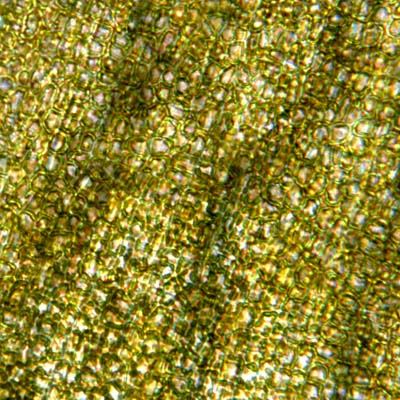
The Unique Kelp
MORPHOLOGY
Epidermal cells of the blade containing plastids (each cell 2 micrometers, 40x)
Epidermal layer (3 micrometers), cortex (9 micrometers), medulla (3 micrometers)
Isodiametric (~2 micrometer diameter) and cluster of elliptical medulla cells (1 micrometer long axis) |
|
WHAT MAKES CYMATHERE A UNIQUE KELP? Cymathere triplicata is characterized by three distinct longitudinal folds in the center of the blade and a discoid holdfast (1). Often, young specimens of C. triplicata will only have 2 folds, due to the progressive growth of these folds with age. There have been rare documentations of large specimens of C. triplicata with four central folds instead of three (2). There are pits present in the walls of all three cell layers (meristoderm, cortex, and medulla), but unlike most members of Order Laminariales, these pits are not arranged circularly. In C. triplicata, their arrangement is random (1).
OTHER KELP ATTRIBUTES OF CYMATHERE There are three types of cell layers in kelps; the meristoderm, the cortex, and the medulla. Each section of the kelp (the holdfast, stipe, and blade) is characterized by different shapes, sizes, and attributes of these three layers. The meristoderm of the discoid holdfast is referred to as the meristoderm and is clearly seen in crossection. The cortex and medulla are fairly indistinguishable from one another (1). The meristoderm of the stipe consists of 5-10 cells, increasing in size as they approach the cortex and medulla. These cells contain many plastids and give kelp their characteristic golden-green color. The cortex of the stipe (located between the meristoderm and the medulla) is composed of a number of circular cells. The transition from the cortex to the medulla in C. triplicata is very abrupt. The medulla is characterized by a filamentous, central aggregation of elliptical cells (1). The area between the stipe and blade is referred to as the transition region, and is usually rather thick and stiff. The blade’s epidermal cell layer is generally thinner than that of the stipe, and may contain sporangia. Mucilage ducts are present in the cortex layer of the transition region (unlike the holdfast and stipe) and the medulla is typically thin (1).
Website created by: |
1) Smith, A. I. 1939. The comparative histology of some of the Laminariales. American Journal of Botany 26,8:571-585.
2) Griggs, Robert F. 1907. Cymathere, a kelp from the western coast. The Ohio Naturalist 7,5:89-96.


